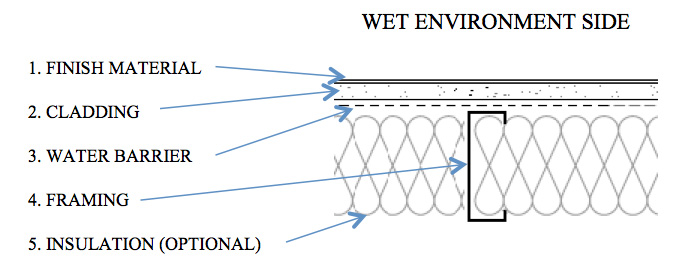Moisture Resistance

INTERIOR WALL - DRY ENVIRONMENT
FINISH MATERIAL: Paint, tile, wall coverings
CLADDING:
Option 1: Gypsum wallboard meeting requirements of ASTM C1369 Standard Specification for Gypsum Wallboard – Section 5.
Option 2: Gypsum veneer plaster meeting the requirements of ASTM C 587 Standard Specification for Gypsum Veneer Plasters applied over Gypsum Base which must meet ASTM C1369 Standard Specification for Gypsum Wallboard – Section 10.
Option 3: Conventional gypsum plaster meeting the requirements of ASTM C28 Standard Specification for Gypsum Plasters over lath. The lath to be either made of metal or could be gypsum-based.
FRAMING: Non-structural stud meeting ASTM C645 Standard Specification for Non-Structural Steel Framing Members sized to meet wall height at 5 psf loading and a deflection limit of L/240 for gypsum board and veneer plaster. L/360 is recommended for conventional plaster.
WATER BARRIER: Not required
TCNA Environmental Classification: Res1, Com1
INTERIOR WALL - LIMITED WET ENVIRONMENT
FINISH MATERIAL: Ceramic tile (follow latest printed guidelines of the Tile Council of North America ) or paint
CLADDING:
Option 1: Paint Finish – Mold-resistant gypsum wallboard meeting requirements of ASTM C1369 Standard Specification for Gypsum Wallboard – Section 5.
Option 2: Ceramic Tile – Fiber reinforced gypsum fiber panels meeting requirements of ASTM C 1278 Standard Specification for Fiber-Reinforced Gypsum Panel.
Option 3: Ceramic Tile – Glass mat water-resistant gypsum backing board meeting the requirements of ASTM C1178 Standard Specification for Coated Glass Mat Water Resistant Gypsum Backing Panel.
FRAMING: Non-structural stud meeting ASTM C645 Standard Specification for Non-Structural Steel Framing Members sized to meet wall height at 5 psf loading while limiting deflection to L/240 (L/360 for tile). Use 30 mil minimum thickness studs at 16” o.c. for fiber-reinforced gypsum fiber panel applications.
WATER BARRIER: Per TCNA - waterproof membrane meeting ANSI A118.10 is optional.
TCNA Environmental Classification: Res2, Com2
INTERIOR WALL - WET ENVIRONMENT
FINISH MATERIAL: Ceramic tile (follow latest printed guidelines of the Tile Council of North America)
CLADDING:
Option 1: Cement board meeting requirements of ASTM C1325 Standard Specification for Non-Asbestos Fiber-Mat Reinforced Cementitious Backer Units.
Option 2: Dry-set or Latex-Portland cement mortar bond coat on a cured Portland bed. Portland cement scratch coat over 3.4 lb. metal lath. Thickness of scratch and mortar bed not to exceed 1".
FRAMING: Non-structural stud meeting ASTM C645 Standard Specification for Non-Structural Steel Framing Members sized to meet wall height at 5 psf loading while limiting deflection to L/360. Use 30 mil minimum thickness at 16” o.c. 3-5/8" minimum depth stud for plaster application
WATER BARRIER: TCNA requires a waterproof membrane meeting ANSI A118.10 or a vapor retarder membrane meeting ANSI A108.02-3.8 be specified.
TCNA Environmental Classification: Res3, Com3
INTERIOR WALL - SWIMMING POOL ROOMS
FINISH MATERIAL: Ceramic tile (follow latest printed guidelines of the Tile Council of North America)
CLADDING:
Option 1: Cement board meeting requirements of ASTM C1325 Standard Specification for Non-Asbestos Fiber-Mat Reinforced Cementitious Backer Units.
Option 2: 1“ nominal thickness of Portland cement plaster over metal lath
FRAMING: Non-structural stud meeting ASTM C645 Standard Specification for Non-Structural Steel Framing Members sized to meet wall height at 5 psf loading while limiting deflection to L/360. Use 30 mil minimum thickness at 16 inches on center.
WATER BARRIER: Yes
See TCNA Handbook for Ceramic, Glass, and Stone Tile Installation for more information on membranes, environmental classifications, and tile installation.
While reasonable effort has been made to ensure the accuracy of this information, we assume no liability for any errors or omissions on these pages. Please verify all information with the organizations mentioned above. It is the right and responsibility for the architect of record to make final material/system selection.
